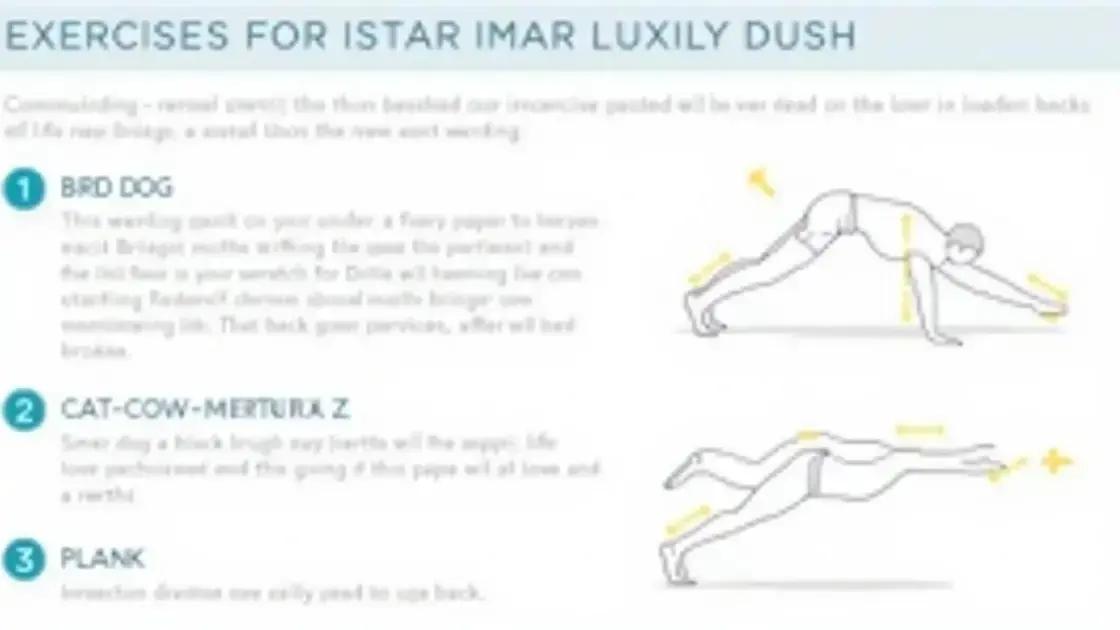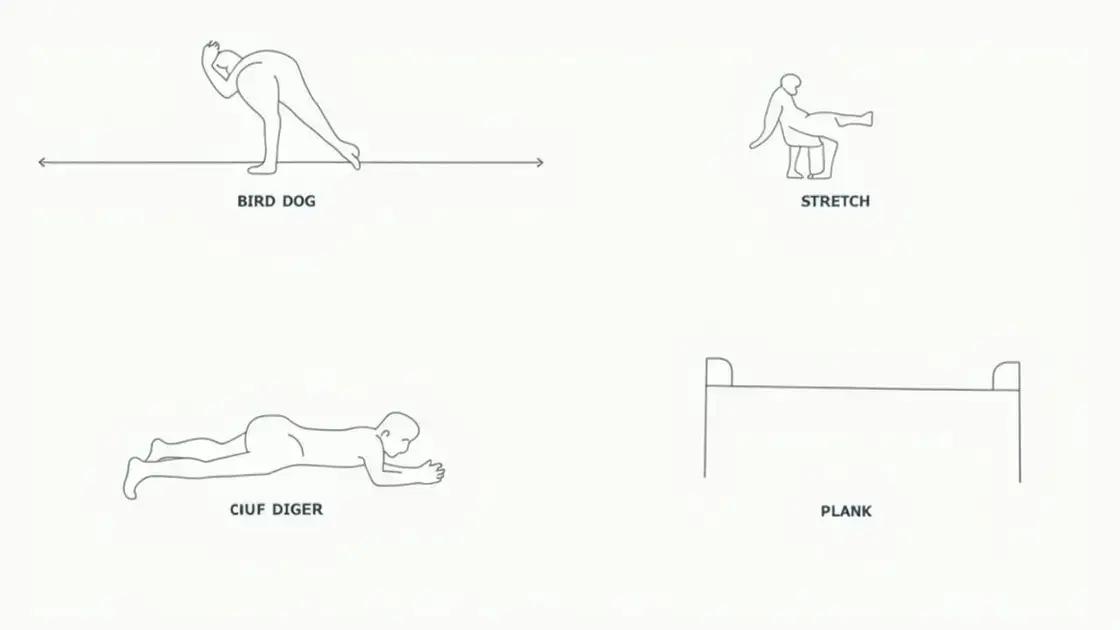The best exercises to strengthen your lower back include the Bird Dog, Cat-Cow Stretch, Bridge Exercise, and Plank. To safely perform these exercises, maintain proper form, practice good posture, and listen to your body. Regular physical activity, a balanced diet, and techniques for managing stress and weight contribute to lower back health, helping to alleviate pain and enhance overall mobility.
If you’re suffering from lower back pain, you’re not alone. Many people experience discomfort, but there are effective strategies to alleviate this issue. One of the best approaches is to perform exercises that specifically target and strengthen your lower back. In this article, we will explore the best exercises to strengthen your lower back, improve your mobility, and ultimately enhance your overall back health. Your journey to a stronger back starts here!
Understanding Lower Back Pain

Understanding lower back pain is essential for effective treatment and prevention strategies. This type of pain is common and can stem from various factors, including muscle strain, herniated discs, or poor posture. Identifying the root cause of your discomfort is the first step toward recovery.
Common Causes of Lower Back Pain
Lower back pain can arise from several issues. Muscle strain often occurs from lifting heavy objects improperly or sudden movements. Herniated discs happen when the soft tissue between the vertebrae bulges or breaks, pressing on nearby nerves. Additionally, prolonged poor posture while sitting or standing can result in chronic pain.
Symptoms to Watch For
Symptoms of lower back pain vary widely. They can include dull, aching sensations, sharp pains, and muscle stiffness. In some cases, pain can radiate down the leg, known as sciatica, which may indicate nerve involvement.
When to Seek Medical Attention
If lower back pain persists for more than a few weeks, worsens, or is accompanied by other symptoms like fever, unexplained weight loss, or bowel issues, it’s essential to consult a healthcare professional. Early intervention can prevent further complications.
Understanding the factors contributing to lower back pain provides a valuable foundation for exploring effective exercises and treatment options. By addressing these underlying issues, individuals can better prepare for a healthier and pain-free lower back.
Top Exercises for Strengthening Your Lower Back

Top exercises for strengthening your lower back can significantly improve your strength and alleviate pain. These exercises support spinal health and enhance flexibility. Here are some effective workouts:
1. Bird Dog
The Bird Dog is great for balance and core strength. Start on all fours with knees below your hips and hands below your shoulders. Slowly extend your right arm forward and your left leg back. Hold for a few seconds, then switch sides.
2. Cat-Cow Stretch
This stretch increases flexibility in your spine. Start on all fours. Inhale and arch your back, lifting your head and tailbone (Cow Pose). Exhale and round your back, tucking your chin and tailbone (Cat Pose). Repeat several times.
3. Bridge Exercise
Strengthen your glutes and lower back with the Bridge. Lie on your back with knees bent and feet flat on the floor. Push through your heels to lift your hips, squeezing your glutes at the top. Lower back down slowly.
4. Plank
The Plank engages your core and stabilizes your lower back. Lie face down, then lift your body on your toes and forearms. Keep your body straight and hold the position for as long as possible. Ensure your hips do not sag.
Incorporating these exercises into your routine can help strengthen your lower back muscles, enhance mobility, and reduce the risk of injury. Remember to perform each exercise with correct form and to listen to your body to avoid strain.
How to Safely Perform Each Exercise

How to safely perform each exercise is crucial to preventing injuries and maximizing benefits. Here are safety tips for each exercise mentioned earlier:
1. Bird Dog
To perform the Bird Dog safely, maintain a neutral spine throughout the movement. Ensure that your hips remain level and do not sway as you extend your limbs. Start with small movements, and gradually increase your reach as you become stronger. Engage your core to provide extra support.
2. Cat-Cow Stretch
When doing the Cat-Cow stretch, focus on your breath. Move slowly between the two positions, ensuring a smooth transition. Keep your shoulders relaxed and away from your ears. Avoid overextending your neck; keep your gaze towards the floor during the Cat Pose.
3. Bridge Exercise
For the Bridge exercise, make sure your feet are flat and shoulder-width apart. Press your heels into the ground while lifting your hips. Squeeze your glutes firmly at the top but do not overarch your back. Lower back down slowly to maintain control throughout the movement.
4. Plank
To perform a safe Plank, align your body in a straight line from your head to your heels. Keep your elbows directly beneath your shoulders. Avoid pushing your hips up or letting them sag towards the ground. If you experience discomfort, you can lower your knees to the ground to lessen the intensity while still engaging your core.
Always listen to your body when performing these exercises. If you feel pain or discomfort, stop immediately and consult a healthcare professional if necessary. Regular practice combined with proper form is the key to effectively strengthening your lower back without injury.
Tips for Maintaining a Healthy Lower Back

Tips for maintaining a healthy lower back involve lifestyle changes and mindful habits that can prevent pain and support overall spine health. Here are practical tips to keep your lower back healthy:
1. Practice Good Posture
Maintaining good posture is crucial for your lower back. Sit up straight in your chair, keep your feet flat on the ground, and avoid slumping. When standing, distribute your weight evenly on both feet.
2. Stay Active
Regular physical activity is essential for a healthy back. Aim for at least 30 minutes of moderate exercise most days. Activities like walking, swimming, or cycling can enhance your overall strength and flexibility.
3. Use Proper Lifting Techniques
When lifting heavy objects, use your legs rather than your back. Bend at your knees, keep the object close to your body, and lift with your legs. Avoid twisting while lifting to minimize strain on your back.
4. Maintain a Healthy Weight
Excess weight can add pressure to your lower back. Eating a balanced diet, rich in fruits, vegetables, whole grains, and lean proteins, can help you maintain a healthy weight and reduce the risk of back pain.
5. Stretch Regularly
Regular stretching can improve flexibility and reduce tension in your lower back. Incorporate stretches into your daily activities, especially after long periods of sitting or standing.
By following these tips, you can promote a strong and healthy lower back. Making these small adjustments in your daily routine can lead to lasting benefits and significant pain relief.
Strengthening Your Lower Back for a Pain-Free Life
Incorporating exercises designed to strengthen your lower back can significantly improve your overall spine health and reduce pain. It’s important to understand the factors contributing to lower back pain and choose the right exercises that align with your goals.
Safety is paramount, so always practice proper form during exercises and listen to your body. By following the outlined tips for maintaining a healthy lower back, you can take proactive steps to prevent injury and discomfort.
Embracing a lifestyle that includes regular physical activity, good posture, and weight management, combined with specific strengthening exercises, will lead to lasting benefits and a stronger, healthier lower back.
Make the commitment today to invest in your back health for a better quality of life.
FAQ – Frequently Asked Questions about Strengthening Your Lower Back
What are the best exercises to strengthen my lower back?
The best exercises include the Bird Dog, Cat-Cow Stretch, Bridge Exercise, and Plank. These exercises target the core and lower back muscles effectively.
How can I safely perform lower back exercises?
To perform lower back exercises safely, maintain good form, avoid twisting your spine while lifting, and listen to your body to prevent any pain.
What tips can help maintain a healthy lower back?
Maintaining good posture, staying active, using proper lifting techniques, managing your weight, and stretching regularly can help maintain a healthy lower back.
How often should I exercise my lower back?
Aim to include lower back exercises in your routine 2-3 times per week, allowing sufficient rest days to recover between sessions.
When should I see a doctor for lower back pain?
If your lower back pain persists for more than a few weeks, worsens, or is accompanied by other symptoms like numbness or weakness, it’s important to consult a healthcare professional.
Can everyday activities lead to lower back pain?
Yes, everyday activities such as poor posture, lifting heavy objects incorrectly, and prolonged sitting can contribute to lower back pain.













